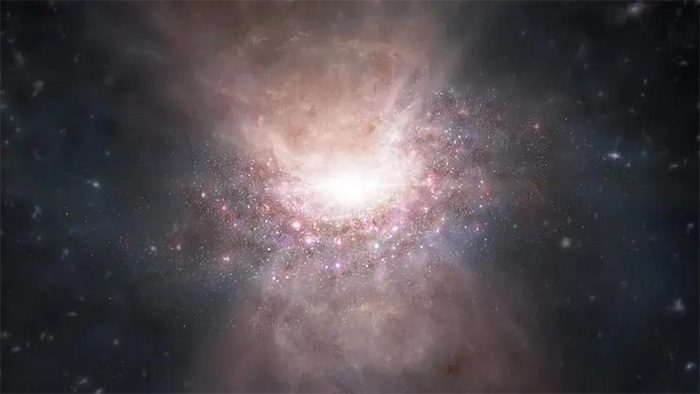The ALMA Telescope Captures Chilling Image from Nearly 13 Billion Years Ago, Where Streams of Deadly Gas are “Slaughtering” a Galaxy.
The source of the massive high-speed gas jets is a quasar – a super-bright black hole that is currently devouring material, named J2054-0005. The “victim” galaxy has lost its ability to form stars due to this brutal attack.

Quasar J2054-0005 shines brightly in the early universe while “slaughtering” a galaxy – (Image: ALMA/ESO/NAOJ/NRAO).
According to a publication in the scientific journal Astrophysical Journal, these molecular gas streams are composed of oxygen bonded with hydrogen. They are the primary fuel for star formation.
However, when the black hole speeds too rapidly into the galaxy, developing stars may experience “overfeeding.” This drastically reduces the star formation capability in the quasar’s vicinity.
According to Live Science, this chilling moment was captured by the ALMA Telescope, a massive and powerful radio observation network located in Chile.
With its “stunning” vision, ALMA has looked back to a time just 900 million years after the Big Bang that birthed the universe. The Big Bang occurred approximately 13.8 billion years ago.
Since light takes time to travel corresponding to distance, this catastrophic event is an image from 13 billion years ago, situated at a point that was once 13 billion light-years away from Earth.
In reality, if the galaxy or the black hole still exists, they have been pushed far away due to the expansion of the universe. It is even more likely that both have long since disappeared.
However, thanks to the delay in the recorded image, ALMA inadvertently allows humanity to see a complete picture of what transpired in the early universe nearly 13 billion years ago.
This new discovery from ALMA may partially explain some recent observations indicating that the early universe harbored many faint galaxies resembling ghosts. They may have been attacked by wild quasars in the universe 13 billion years ago, leading to poor star formation.
In addition to expelling gas outwards with powerful light beams, quasars can also eject nearby material at speeds close to the speed of light due to their tremendous rotational velocities.
With all the confirmed phenomena related to quasar J2054-0005, the research team led by Associate Professor Dragan Salak from Hokkaido University (Japan) hopes that astronomers will discover more such quasars in the future, using increasingly advanced tools.
These findings will help to better understand the luminous hearts of the first galaxies in the universe, which are gigantic black holes that challenge long-standing astronomical theories.


















































